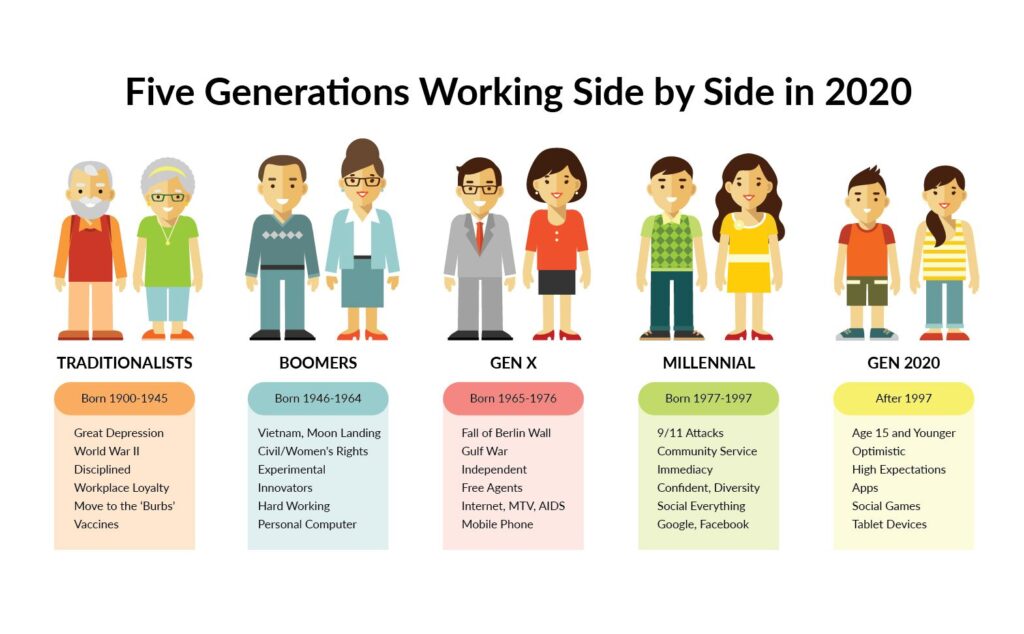
Generations by Year: A Comprehensive Guide to Understanding Generational Differences
Understanding the various generations and their defining characteristics is crucial in today’s interconnected world. From the Silent Generation to Gen Alpha, each cohort has been shaped by unique historical events, technological advancements, and societal shifts. This article provides a comprehensive overview of generations by year, exploring their key traits, values, and impact on society. Understanding these generational nuances can foster better communication, collaboration, and overall understanding in both personal and professional settings.
Defining Generations: An Overview
A generation, in sociological terms, refers to a group of people born around the same time and sharing similar cultural experiences. The exact year ranges defining each generation can vary slightly depending on the source, but the generally accepted ranges are outlined below. Understanding generations by year helps us appreciate the diverse perspectives and experiences that shape our world.
The Greatest Generation (Born 1901-1927)
Also known as the G.I. Generation, this cohort lived through the Great Depression and fought in World War II. Their defining characteristics include a strong work ethic, patriotism, and a sense of duty. They are known for their resilience and commitment to building a better future after the war. This generation by year is characterized by sacrifice and community spirit.
The Silent Generation (Born 1928-1945)
Growing up during times of economic hardship and global conflict, the Silent Generation is known for their cautiousness, conformity, and respect for authority. They value stability and security and tend to be fiscally conservative. Understanding this generation by year reveals their emphasis on tradition and order.
Baby Boomers (Born 1946-1964)
One of the largest generations, Baby Boomers were born during a period of increased birth rates following World War II. They experienced significant social and cultural changes, including the Civil Rights Movement, the Vietnam War, and the rise of rock and roll. Baby Boomers are often characterized by their optimism, competitiveness, and dedication to their careers. The impact of this generation by year on society is undeniable.
Generation X (Born 1965-1980)
Often described as the “latchkey generation,” Gen Xers grew up during a time of increasing divorce rates and economic uncertainty. They are known for their independence, resourcefulness, and skepticism. They witnessed the rise of personal computers and the early stages of the internet. Understanding generations by year, Gen X is often seen as a bridge between the analog and digital worlds.
Millennials (Born 1981-1996)
Also known as Generation Y, Millennials came of age during the dot-com boom and the 9/11 attacks. They are often characterized by their tech-savviness, optimism, and desire for work-life balance. They are also known for their entrepreneurial spirit and social consciousness. This generation by year has significantly impacted the workplace and consumer culture. [See also: Millennial Workplace Trends]
Generation Z (Born 1997-2012)
Gen Z, also known as Zoomers, are true digital natives, having grown up with the internet and social media. They are known for their pragmatism, diversity, and social activism. They are comfortable with technology and are adept at multitasking and information filtering. Understanding the characteristics of this generation by year is crucial for businesses and educators alike.
Generation Alpha (Born 2013-2025)
The newest generation, Generation Alpha, is still young, but they are already being shaped by technology, globalization, and the COVID-19 pandemic. They are expected to be the most educated, technologically advanced, and globally connected generation yet. Studying this generation by year provides insights into the future of society. [See also: The Future of Education]
Key Differences and Common Traits Among Generations
While each generation has its unique characteristics, there are also common threads that connect them. Understanding these similarities and differences can help bridge generational gaps and foster better communication. For example, while Millennials and Gen Z are both tech-savvy, their approaches to technology and social media differ significantly. Baby Boomers and the Silent Generation share a strong work ethic, but their values and priorities may differ. Examining these generations by year reveals patterns and trends that shape society.
The Impact of Generational Differences on the Workplace
Generational differences can have a significant impact on the workplace. Different generations may have different communication styles, work habits, and expectations. Understanding these differences is crucial for creating a diverse and inclusive work environment. For example, Millennials and Gen Z often prioritize work-life balance and opportunities for growth, while Baby Boomers may value stability and loyalty. Recognizing the nuances of these generations by year is key to effective management and collaboration.
Marketing to Different Generations
Marketing strategies must be tailored to appeal to different generations. What works for one generation may not work for another. For example, Millennials and Gen Z are more likely to respond to social media marketing and influencer campaigns, while Baby Boomers may prefer traditional advertising channels. Understanding the values and preferences of each generation by year is essential for effective marketing. [See also: Digital Marketing Strategies]
Bridging the Generational Gap
Bridging the generational gap requires empathy, understanding, and a willingness to learn from each other. By recognizing the unique perspectives and experiences of each generation, we can foster better communication, collaboration, and mutual respect. Open communication, active listening, and a willingness to compromise are essential for bridging the generational gap. Recognizing these generations by year helps us build a more inclusive and understanding society.
Generational Cohorts: A Timeline
- The Greatest Generation (Born 1901-1927)
- The Silent Generation (Born 1928-1945)
- Baby Boomers (Born 1946-1964)
- Generation X (Born 1965-1980)
- Millennials (Born 1981-1996)
- Generation Z (Born 1997-2012)
- Generation Alpha (Born 2013-2025)
Conclusion
Understanding generations by year is essential for navigating the complexities of modern society. Each generation has been shaped by unique historical events, technological advancements, and societal shifts. By appreciating the diverse perspectives and experiences of each cohort, we can foster better communication, collaboration, and overall understanding in both personal and professional settings. As we move forward, it is crucial to continue studying and adapting to the evolving characteristics of each generation.
